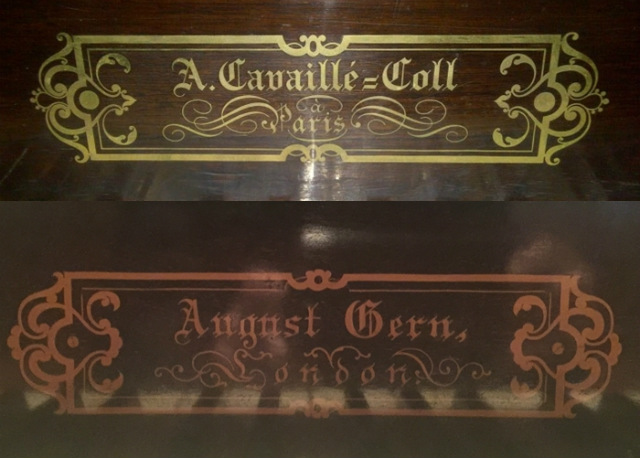This post is part of a series where I share some of my world travels which my love for organs has taken me. I help friends, associates and fellow organ lovers with projects that mean I get to see new and old organs in gorgeous settings and really experiment with this instrument.
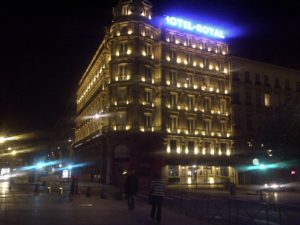
I expect that most people’s thoughts on visiting Lyon will be it’s reputation as the culinary capital of France. Having experienced a range of restaurants I was left a little under whelmed by the cuisine, but impressed with the blend of old and new and a very uplifting feeling to the town. (Picture of our hotel – right).
My trip out was to assist in the recording of some of the more obscure works of Lyon-born organist Charles-Marie Jean Albert Widor (21 Feb 1844 – 12 Mar 1937) on the magnificent Cavaille-Coll organ. The venue was in the now little used church of St François-de-Sales, situated in the aptly named Place de Charles Widor in a Victorian part of the town.
The road from Oxfordshire to Lyon…
Having driven from Oxfordshire at high speed we made our shuttle crossing with just seconds to spare and spent the first night at Amiens, arriving so late that only the culinary delight of a McDonalds was available to feed the exceptionally hungry. An early start the following day with pedal firmly to the metal saw a late afternoon arrival in Lyon in the pouring rain. Only 2 circuits of the town were necessary to find the hotel which by past performance in other venues could be considered quite good.
The warm up…
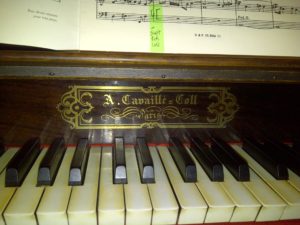 My heroic performer, who I regularly use when turning pages, had arrived a day earlier and had already limbered up on the instrument. This is almost the last built by the French organ maker Aristide Cavaille–Coll (4 Feb 1811 – 13 Oct 1899). It was installed in 1880 and remains very much in it’s original condition. Indeed though not large, Cavaille-Coll considered it to be one of his best.
My heroic performer, who I regularly use when turning pages, had arrived a day earlier and had already limbered up on the instrument. This is almost the last built by the French organ maker Aristide Cavaille–Coll (4 Feb 1811 – 13 Oct 1899). It was installed in 1880 and remains very much in it’s original condition. Indeed though not large, Cavaille-Coll considered it to be one of his best.
The recording crew were still travelling. The night before they were in Frankfurt for a live performance, so one can only guess how little sleep they had managed before setting off for a long drive to Lyon. Finally the entire team was assembled and action could begin.
Setting the scene…
Several hours were spent setting up the equipment and a studio was created in an adjacent sacristy complete with all the usual facilities that only French plumbing, unchanged from original installation some 150 years earlier, can provide. Our hosts were charming and the freedom to record in a mostly closed church is a very rare privilege indeed. So quiet was this part of town that we were even deprived of the usual need to work late into the night in order to rid ourselves of the inevitable traffic noise. Our only hazard was the church clock striking every half hour and after a while we were even able to anticipate that and delay our starts. So quite unusually by 9pm most evenings it was off to the restaurants and bars. Very civilised!
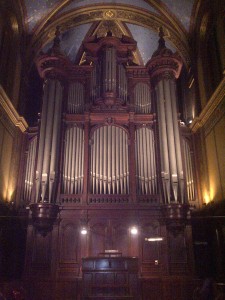
If hearing “Cavaille-Coll” gets you thinking of a huge west end organ set high above the main door, then your initial entrance to Saint François-de-Sales will be disappointing. Here…the organ is set at the rear of the east end. No high loft to climb to and cocoon the musician in elevated privacy, but a console in full view at floor level directly in front of the organ case, which rises to perhaps no more than 40 ft above the musician. In fact by most of his instrument standards, this is on a rather small scale. The church is not large and one inevitably anticipates disappointment. There is also no 32ft reed and the 32ft sub bass was not playing. (Organ pictured – left)
The listening experience…
In describing the above however you need not worry – for this instrument provides one of the most thrilling listening experiences of any. It just all works perfectly. Perhaps the fact that the musician is so close to the pipe work, and the sound can not disappear into the usual high spaces above and beyond the console. The lack of instrument size is more than adequately compensated by a strong acoustic. Perhaps also the relative size of organ to building, here at great extreme is key, but whatever magic has been spun, the overall result is just as astounding as most of Cavaille-Coll’s other instruments built on far larger scale in bigger spaces.
The challenge of the Cavaille-Coll…
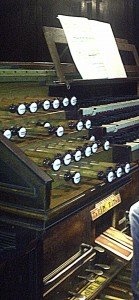
Those of you not expert with page turning may not be familiar with the additional challenges Cavaille-Coll’s instruments impose, the assistant often being required to help with registration changes. This requires the use of foot pedals that bring extra stops into play. These pedals (seen in the picture on the right), known as Ventils, lie just above the pedal board, and more often than not need to be depressed at just the same time the musician has their feet in the way busy playing the notes. Seldom does the musician pay the slightest heed of the page turner’s task and the additional pressure of these extra (and usually unremunerated) jobs falls on the unsung assistant who battles on in silence.
The stops are set on terraces, with particularly long draws. So they are far from easy for the player to manage alone. No pistons or sequencer here to make life easy! (See pictures below for left and right stop jambs respectively.)
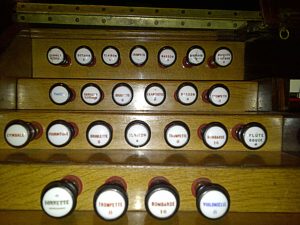
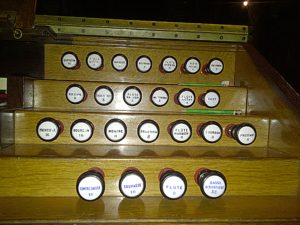
In just 3 sessions the recording was completed with much time to spare. Widor gave the first performance of his 5th symphony on this very instrument so with time also available on the CD a recording of the famous Toccata from this work was also made. What more appropriate than to record that piece on the very instrument it was first performed by the composer? My valiant assistant playing the notes had done his usual faultless performance showing extraordinary mastery of both instrument and music.
And then we were done…
When we were done, the equipment was packed away, the organ blowers switched off, and the doors closed. Once again this engineering ‘work of art’ fell silent in an almost forgotten building, open now only in the mornings to but a few tourists and for the occasional service. A great privilege to hear and play but now tucked away and sadly silent for much of the time denying enjoyment and the purpose its genius builder devoted a lifetime’s work to create.
Want to hear what we recorded?
You can look out for the CD which will be released by Signum in 2014. It will introduce you to a wonderful instrument and Widor’s less well known but charming works on a smaller scale than the great symphonies. These are the Suite Latine, Trois Nouvelles Pieces and Bach’s Memento.
If you are interested in my travels and organ experiences, make sure you follow the series. Similarly if you have had a great (or even a small) adventure with a historic organ and want to share it with me or my blog readers – then please feel free to comment below to let us all know about it.
I have had a passion for church organs since the tender age of 12. I own and run Viscount Organs with a close attention to the detail that musicians appreciate; and a clear understanding of the benefits of digital technology and keeping to the traditional and emotional elements of organ playing.
